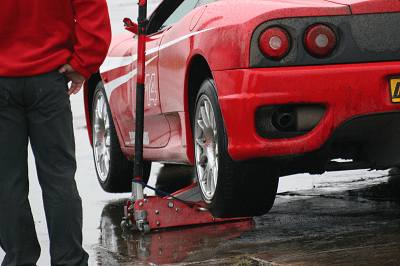What Is a Low Jack?
 A low jack is a type of “floor jack” mainly used for automobile maintenance.
A low jack is a type of “floor jack” mainly used for automobile maintenance.
It is used for vehicles that have been modified to lower the vehicle height, such as lowered cars, sports cars, and cars with external aero parts installed, where the gap between the ground and the vehicle body is small and the jack-up point is difficult to access. The arm part designed for lifting the car body is typically made flat. This design allows the jack to easily enter the gap even when the car height is low, and the space between the ground and the car body is limited.
While it is easier to jack up a vehicle in a more secluded location than a standard floor jack, the maximum height when jacking up is lower due to the flat arm.
Uses of Low Jacks
Low jacks are mainly used to lift a car’s body when changing tires or oil.
Hydraulic power is used to lift the vehicle body, and low jacks are characterized by a flat, low-floor design of the arm portion used to lift the vehicle body compared to a standard floor jack. It can be used for maintenance of lowered cars, sports cars, cars that have been lowered to a low height, or cars with external aero parts installed that have reduced the gap between the car body and the ground.
Some jacks can be easily disassembled for easy transportation, and some come with a special carrying bag. They are also used for maintenance on the go, such as at a racetrack or on a business trip.
Features of Low Jacks
Compared to a regular floor jack, low jacks have a flat, thin arm that is used to lift the car body when jacked up. This makes it possible to access the jack-up point even for vehicles with a small gap between the ground and the vehicle body.
- Gap required for normal floor jacks: 5″ minimum
- Gap required for low jacks: minimum 3″
Although there are some differences among products, a minimum clearance of 5″ (135 mm) is required between the ground and the car body for a standard floor jack. In contrast, low jacks can be used with a gap of 3″ (80 mm).
Therefore, maintenance can be performed by jacking up a lowered car that has been intentionally lowered by modifying the vehicle’s suspension, or a car with external aero parts that have reduced the gap between the ground and the car body, without any interference.
How to Select a Jack
When selecting a jack, it is necessary to check the “maximum load capacity,” “minimum height,” “maximum height,” and “jack drive system.”
1. Maximum Load Capacity
This is the maximum weight that can be lifted with a jack. If you try to lift more than this weight, in the worst case, the jack may be damaged and the car may suddenly fall while being jacked up.
Be especially careful with minivans and SUVs, as many of these vehicles are large and heavy. Since the vehicle weight is listed on the vehicle inspection certificate, it is recommended that the maximum load capacity be selected with a margin of safety.
2. Minimum and Maximum Height
It is necessary to check the lowest height between the ground and the vehicle body that can be handled with a jack (minimum height) and the height when the vehicle body is lifted to the maximum height with a jack (maximum height). The minimum height, the lowest height between the ground and the body of the vehicle, is whether there is clearance to use a jack, but also note the maximum height when the vehicle is lifted to its maximum height.
In some cases, when a jack is used to jack up the vehicle, the maximum height of the jack is reached even though the vehicle is barely lifted, making it impossible to work with the jack. This is especially common with SUVs that have a high standard vehicle height.
3. Jack Drive System
There are four major types of jack drive systems:
- Manual type
- Hydraulic type
- Electric
- Pneumatic type
Although there is little difference in jack performance, each type is different in terms of ease of use when raising and lowering the jack. Therefore, please consider which drive system to choose in light of your budget and frequency of use.
Other Information on Low Jacks
Points to Note When Using Jacks
When using a jack, it must be used on a flat, stable surface. If the jack is used on a slope or on gravel, it will not be stable, and the vehicle being jacked up may come off the jack and fall.
Unless the drive system is manual, loosening the release valve will lower the jack. However, care must be taken when loosening the valve because the vehicle will also fall suddenly if the valve is loosened abruptly.